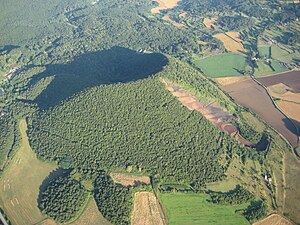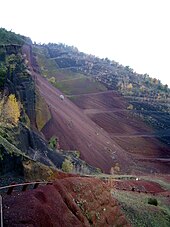Croscat
| Croscat | ||
|---|---|---|
|
Aerial view of the Croscat volcano |
||
| height | 786 msnm | |
| location | Girona Province , Catalonia | |
| Coordinates | 42 ° 9 '15 " N , 2 ° 32' 9" E | |
|
|
||
| Type | Pyroclastic cone , stratovolcano , Stromboli type | |
| rock | basalt | |
| Age of the rock | Holocene | |
| Last eruption | 11,500 years ago | |
The Croscat volcano is an extinct volcano between the municipalities of Santa Pau and Olot in the Comarca Garrotxa in the Spanish autonomous region of Catalonia .
The horseshoe-shaped 786 meter high mountain of the Stromboli type is located northwest of Santa Pau in the nature reserve Volcanoes of the Garrotxa , has a diameter of 800 meters at the base and a 160 meter high cone , the highest of a volcano on the Iberian Peninsula . He also seems to be the youngest. The crater is on the west side. At the highest point on the crater rim are the remains of an old defense tower, now equipped with antennas for telecommunications. On the east side, granules of clay minerals have been mined over the past three decades . Through an eruption, the Croscat has exposed its own layer structure in the form of a conic for everyone to see.
Two eruptions are known, one 17,000 years ago and the last 14,000 years ago. The first eruption must have been more significant for the people already living in the area, its lava covered an area of about 20 square kilometers.
At the mountain lies the Fageda d'en Jordà , a beech forest belonging to the Garrotxa Volcanoes Nature Reserve on the lava of the Croscat.
Web links
- Official website of the Zona volcànica de la Garrotxa
- Volcans a Catalunya
- Volcà del Croscat - Topographic map of the area at the Cartographic and Geological Institute of Catalonia.


